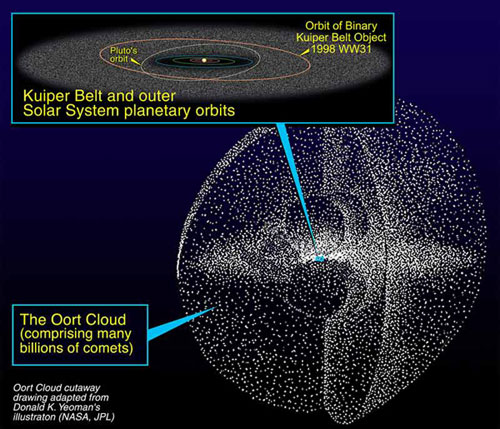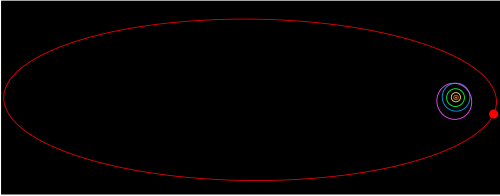Page 8 of 10
Re: Hyperspace
Posted: Thu Aug 25, 2011 8:37 am
by Cy83r
Negative hyperspace... this is one of those brain-melting concepts like sideways time, isn't it?
Re: Hyperspace
Posted: Thu Aug 25, 2011 4:47 pm
by GeoModder
Trantor wrote:Would also like to see if
Nemesis is real.
The possibility of course is there, but I think not. If even medium-sized KBO's can be detected, I reckon an object the size of Jupiter with 80+ times its mass must be like the proverbial spotlight in our sun's neighbourhood.
Re: Hyperspace
Posted: Sat Aug 27, 2011 2:47 pm
by Mjolnir
Trantor wrote:Would also like to see if
Nemesis is real.
A red dwarf so close would have been blindingly obvious to IRAS and WISE and observable by ground scopes, if not a naked-eye object.
And in the case of a brown dwarf, we get into the "in a bound orbit" case. Such an object wouldn't sweep past withinin a orbit or two of Neptune and Uranus, it'd stick around and have a regular effect on orbits. Last I heard, such objects have been pretty conclusively ruled out.
Something like Tyche's a bit more likely...a medium-large Oort cloud gas giant. Cold, smaller than 5 Jupiters or further than 10000 AU. Not much support for the existence of such an object, though.
Re: Hyperspace
Posted: Wed Nov 14, 2012 3:37 pm
by Trantor
YAY, necroposting!
Mjolnir wrote:Something like Tyche's a bit more likely...a medium-large Oort cloud gas giant. Cold, smaller than 5 Jupiters or further than 10000 AU. Not much support for the existence of such an object, though.
Surprisingly well guessed, mr Mjolnir!
Not exactly "cold", nor an Oort-object apparently, but a rogue planet:
http://en.wikipedia.org/wiki/CFBDSIR2149-0403
Even more busstations out there?
Re: Hyperspace
Posted: Wed Nov 14, 2012 8:58 pm
by Arioch
CFBDSIR 2149-0403 is ~100 light years away. If there was an object that size in our Oort cloud only 1 light year away, we'd surely have seen it by now.
Re: Hyperspace
Posted: Thu Nov 15, 2012 7:18 am
by Dragoon
I can;t remember or site the episode but was watching some hstory channel show... during a survey of the ort cloud they have discovered an unusual clumping of commets and other objects. This is believed by some astronomers to be signs of a "significant" large body in our extreme outer system.
I don;t believe they were implying it is a nemisis sized object or even a rouge planet but it is definately something large and distant..large enough to be classified as a near planet from what I can remember of the show..I'll see if can find the info and post it...I hate soundign like i am making stuff up


Re: Hyperspace
Posted: Thu Nov 15, 2012 8:10 am
by javcs
I seem to recall something about a 'tenth planet' or planetoid having been found out in the Kuiper Belt. This was, of course, a number of years ago, and what few details I picked up at the time have long since become blurred.
Re: Hyperspace
Posted: Thu Nov 15, 2012 10:10 am
by Absalom
There were several of those announcements back then, Sedna for example. I'm not certain that we'd be guaranteed to have actually seen any Earth-or-larger planets out in the Oort cloud (specifically, I'm not certain that we've observed enough area at the required detail), but am I safe in assuming that we've at least narrowed down the possible direction vectors when looking from the Earth?
Re: Hyperspace
Posted: Thu Nov 15, 2012 4:16 pm
by Arioch
Kuiper belt objects have irregular orbits, but they're still more or less in the plane of the rest of the system from 30-50 AU, and this is probably more or less where they formed. Oort cloud objects are things (mostly comets) that have been gravitationally ejected from the system, and they form a shell extending out in every direction into interstellar space as far as a light year (60,000 AU) or more. We've gotten pretty good at detecting Kuiper belt objects in recent decades (they've found dozens of Pluto-sized objects, hence the recent controversy over Pluto's planetary status), but for the Oort cloud you don't really know where to look. No direct observations of Oort objects have yet been made, as far as I'm aware.

That said, the largest of the known Kuiper belt objects were predicted because of their observed gravitational effects on the other planets, and they are quite small (only a few are larger than tiny Pluto). A Jupiter-mass planet out in trans-Neptunian space would have a very significant, detectable, and predictable effect on the rest of the solar system, and would be easy to find once predicted. There may still be undetected larger-than-Pluto objects out there, but something like Nemesis really isn't possible.
Re: Hyperspace
Posted: Sat Nov 17, 2012 3:43 am
by Karst45
So why did they come with the oort cloud theory?
Re: Hyperspace
Posted: Sat Nov 17, 2012 4:57 am
by fredgiblet
Re: Hyperspace
Posted: Sat Nov 17, 2012 10:07 am
by discord
well, i'll just post
http://en.wikipedia.org/wiki/Frontier:_Elite_II which has a insanely detailed starmap, given that it has oribital data and all such stuff, including history and political data on every system, and it fits on a single dd disk(660kb) the compression is very impressive...
so lets sum it up, 3d engine, lots of 3d objects, huge and detailed starmap(that is actually pretty accurate with the real world), sandbox type game.
actually came up with math for it WAY back and i think it was more stars than bytes on the disk....as mentioned, insane compression.
and as a side note,
http://www.kickstarter.com/projects/146 ... -dangerous david braben is going at it for a third time....could get awesome.
Re: Hyperspace
Posted: Sat Nov 17, 2012 10:15 am
by Arioch
Karst45 wrote:So why did they come with the oort cloud theory?
It started as an attempt to answer the question of where the long-period comets come from... if you plot the orbits of the long-period comets, you notice they come from WAY outside the solar system. If you multiply the number of observed long-period comets by the number that must be out there, especially considering that comets have limited lifespans once they enter the inner solar system, the number gets big fast. In the 50's Jan Oort presented a theory of how these comets got there (gravitational ejection from the early solar proplyd), and as I understand it that theory still fits the observed facts today.
We've never directly observed an Oort object outside the inner solar system because they're tiny, cold, dimly-lit, distant, and in unpredictable orbits. Folks who talk about objects being easy to detect in space need to remember that such objects need to be discerned against the background of the universe, and that's not always so easy unless you know exactly where to look.
Re: Hyperspace
Posted: Sat Nov 17, 2012 4:08 pm
by Suederwind
We've never directly observed an Oort object outside the inner solar system because they're tiny, cold, dimly-lit, distant, and in unpredictable orbits.
Well, as far as I remember there is this "dwarf planet" called Sedna which could belong to some kind of "inner Oort Cloud". But that theory sounded highly speculative to me at that time and I don´t know what changed in the last ~4 years or so.
Re: Hyperspace
Posted: Sat Nov 17, 2012 6:45 pm
by Arioch
I guess that depends on how you choose to define where the Kuiper belt ends and the Oort cloud begins, but even with an aphelion of 937 AU, Sedna is only a tiny fraction of the distance of most of the objects in the Oort cloud.
We've got some wacky stuff out there, and the scales of the outer solar system boggle the imagination.

Re: Hyperspace
Posted: Sat Nov 24, 2012 1:20 am
by Mikk
Perhaps not as spectacular as Nemesis speculation, Big Ben in Peter Watts' Blindsight was a pretty nice barely visible small brow dwarf serving as a stage for some neat alien first contact adventuring. I haven't been able to read a distance for the object out of the book yet tho (PS: you can read PW's works on his website). The distance was expressed through a neicely technobabbly fashion referring to quantum waveform collapse and related magic.
Re: Hyperspace
Posted: Fri Mar 15, 2013 4:43 am
by Trantor
Necroposting FTW!
Arioch wrote:Trantor wrote:Arioch wrote:Given that the frequency of stars seems to go up as the size comes down, it's logical to expect that there are a significant number of brown dwarfs. Unfortunately I haven't seen much current evidence (or even much theory) that soldily predicts how many there are.
Me neither, but related to that link i found an article in a german newspaper where they state that they found
100 new "suns"/brown dwarfs in a radius less than 40 ly around earth.
http://www.spiegel.de/wissenschaft/welt ... 08,00.html
And they say there´s the possibility of even more brown dwarfs, maybe even nearer than proxima centauri.
That would be surprising, if there was one that close and we hadn't detected it. But you never know.
http://en.wikipedia.org/wiki/WISE_1049-5319
Huzzah.
More Busstations.

Works for the Outsiderverse.
Re: Hyperspace
Posted: Fri Mar 15, 2013 7:50 am
by Arioch
The line you quoted was referring to the possibility of a brown dwarf closer than Proxima Centauri, which the example you linked is not.
Re: Hyperspace
Posted: Fri Mar 15, 2013 2:30 pm
by Trantor
Arioch wrote:The line you quoted was referring to the possibility of a brown dwarf closer than Proxima Centauri, which the example you linked is not.
Neither link says that.
Re: Hyperspace
Posted: Fri Mar 15, 2013 8:18 pm
by GeoModder
Trantor wrote:Huzzah.
More Busstations.

Works for the Outsiderverse.
Maybe the mass difference between a G -and L class star is too steep for a safe hyper-jump?

But if not, it looks like a good inbetween jump from Alpha Centauri to Sirius.


